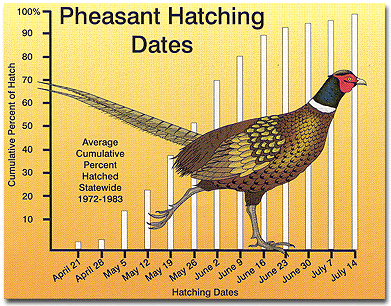Mowing during the summer has a place in wildlife management if done discreetly. Rabbits, pheasants, quail and other upland species use herbaceous stands for nesting and brood/young rearing. Mowing at the wrong time in the growth stage can destroy nests, kill young and scatter broods or litters, making them more susceptible to predation.
Because the timing of mowing upland sites during the summer months is critical, DNR produced these tables on hatching dates for quail and pheasants. Wildlife and Heritage Service field staff collected data that represents excellent sample sizes (20,000+ for quail, 9000 for pheasants). Ideally, DNR mows no upland stands prior to August 1 to allow for late nests and re-nests. As the tables indicated, there is room to move mowing dates earlier to meet other management goals.

Use these tables to guide your decisions, but the general rule is to mow as late as possible.

Wildlife managers recognize the need to mow certain stands periodically during the summer to meet specific management goals. An excellent wildlife practice is to maintain mown strips to produce brood sites for many bird species and succulent vegetation for herbivores. However, several factors must be taken into account.
- Ideally one should mow these strips often enough to discourage their use as nesting sites (keep vegetation less than 8" high) and locate strips near good protective cover.
- Also, mowing half of a five-acre field is usually too much; keep mown strips at the minimum to reach your goals.
- Strip mowing a field is an old, well-established habitat practice, but this can usually be done outside the critical nesting season.
- Mowing trails, roads, farm access lanes, parking areas, around buildings, etc. is a necessary and desirable practice and should be continued. Nevertheless, we can work to keep these applications at a minimum.
Please don't construe this to prohibit the use of mowing as a tool to manage a particular stand for a particular reason. Often newly-established stands benefit from mowing to reduce weed competition, delay dormancy, etc. Clover stands are a good example.
In short, use mowing during the summer months as a management tool where and when it is justified and not as a means of cleaning or keeping busy.
For more information contact:
Maryland Department of Natural Resources
Wildlife and Heritage Service
410-260-8540, or Toll-free in Maryland: 1-877-620-8DNR, ext. 8540.
- Drawings by W.H. Henry